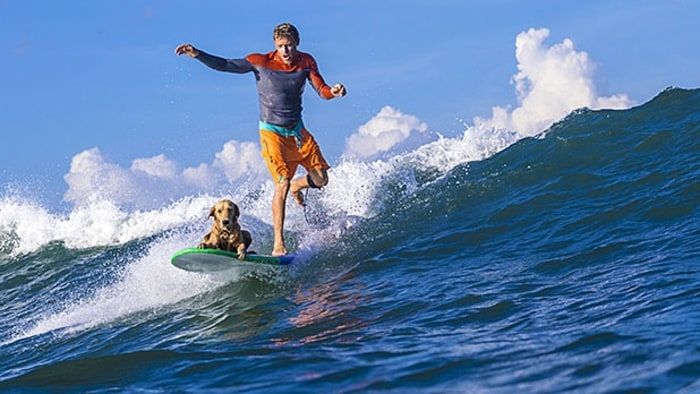How to Surf With Your Dog
When surfing champion-turned-dog-trainer Chris de Aboitiz filmed himself with his dogs catching some surf off the coast of Sydney, Australia, this week, the video went viral. And with the way de Aboitiz's dogs are jumping over his shoulders while he rides in waves, it's not hard to see why. It's a sweet trick, but how can you teach your canine to jump on the board with you in the first place?
"It all comes back to understanding behavior," says de Aboitiz. His work as a dog trainer in his native Australia is rooted in behavioral discipline for dogs. Teaching your canine to surf is "a unique way to not only have fun, but to really connect with your dog, and its behavior," he says. Here are five steps to get your dog out in the water, and on the board, in no time.
Step 1. "Sit, stay."Perhaps the most basic of dog commands — but essential. "How can you put your dog on a board if you don't already have a 'sit, stay'?" These two commands will be the foundation of a successful ride with your dog, so make sure yours knows how to do both.
Step 2. Invite the dog on the board.Familiarize your dog with the board before you even think about leaving the beach. De Aboitiz recommends using a loose piece of rope as a tool to coax the dog onto the board. "You'll have to invite the dog onto the board, and they might not want to come on, so we walk the dog over the board with a leash, and desensitize the dog to the board." He recommends a loose-fitting rope as a leash because buckles and belts can be harmful to the dog later on down the line, once you're on the water. The rope is a guiding tool that is safe, and can become familiar to the dog. "The leash [or, rope] is a tool to get the dog's mind in the right direction. We don't drag the dog onto the board, just give [the leash] a little pop, and say, 'Come, come.' If we drag the dog on, we're not letting it make the choice."
RELATED: How to Surf for the First Time
Step 3. Practice "sit, stay" on the board.It might sound repetitive, but it's important to go over these commands once the dog is comfortable with the board (we're still on the beach at this point). "If we take an excited dog on the board, it's going to want to move around and we're going to fall in and get wet, so practice the 'sit, stay' on the board first. When he's invited on the board, and asked to 'sit, stay,' he's getting structure. He can look around with his head, and his eyes, but he can't move his backside. When he starts to move, he's going to get a verbal correction — 'Don't move!' — and that helps build structure." Structure is key. And so is positioning.
"The position on the board absolutely matters. When we start, first we get people to start on their knees and sit the dog right in front of them, slightly forward of center. Always keep the head of the dog toward the nose of the board so they're always looking forward. After a couple of paddles, they'll look that way because that's the way the hunt is going."
Step 4. Associate the board with a happy place.Just like dogs respond to the jingling of a leash because it indicates a walk, de Aboitiz says you'll want to create the same reaction at the sight of the board. "Once they get comfortable on the board, we like to take them to a happy place." In his native Australia, that means towing the dog on a board out to a sandbar, and then playing a game of fetch. For those without access to sandbars, that could mean fetch on the banks of a lake. "Just get them on the board, invite the dog off the board, throw the stick, let them have some free time, and they quickly associate jumping on the board like jumping into a car and going down to a beach."
RELATED: The 65 Best Surf Spots in the World
Step 5. Introduce the dog to a calm body of water. "Where you need to start is in flat water — a river, or a creek — where you can take the dog for a paddle without hitting the waves. You don't want the dogs having a bad experience, and not wanting to get back on the board." De Aboitiz says most people will remain in flat water, on a paddleboard. It's an exercise that still requires all the discipline and learning that taking your dog out into the waves would, but is a lot safer. "The surf is a little more advanced, there's such power in the waves. That's where you can hurt yourself, hurt your dog, or hurt a bystander." And for those who can't surf themselves, paddleboarding is also another solid option.
